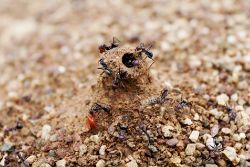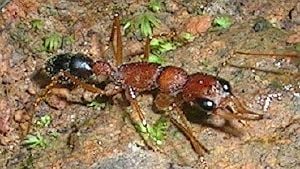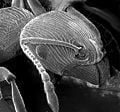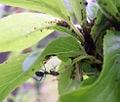Ant
- For other uses, see Ant (disambiguation).
| Ants | ||||||||||||||
|---|---|---|---|---|---|---|---|---|---|---|---|---|---|---|
| Formica rufa worker Formica rufa worker
| ||||||||||||||
| Scientific classification | ||||||||||||||
|
Ants are one of the most successful groups of insects in the animal kingdom and are of particular interest because they are a social insect and form highly organized colonies or nests, sometimes consisting of millions of individuals. Colonies of invasive ant species will sometimes work together and form supercolonies, spanning a very wide area of land. Ant colonies are sometimes described as superorganisms because they appear to operate as a single entity.
Ants have colonized almost every landmass on Earth and can constitute up to 15% of the total animal biomass of a tropical rainforest, in the Amazon the combined weight of the ants is said to be four times larger than that of the tetrapods in the same area. As of 2006, there are 11,880 known ant species, most of which reside in hot climates.
Ancestry
Ants are classified as a family, Formicidae, belonging to the order Hymenoptera which also includes sawflies, bees and wasps. Ants are a lineage derived from within the vespoid wasps. Unlike bees and more advanced wasps, ants have never evolved the ability to build comb cells, which is often an advantage if the colony is under attack and the offspring needs to be moved into safety. Also, the rise of army ants would probably be a lot more difficult if they depended on cells. Molecular clock analysis indicates that ants evolved from other groups of wasps in the Cretaceous period about 140 to 168 million years ago to become the Leptanillinae [1]. After the rise of angiosperms about 100 million years ago, ant evolution also showed rapid change, and about 60 million years ago they really started to achieve ecological dominance. [2]. Several fossils from the Cretaceous are intermediate in form between wasps and ants, further confirming the wasp ancestry of ants. Like other Hymenoptera, the genetic system employed by ants is Haplodiploidy.
In 1967 Wilson et al. obtained the first remains of an ant from the cretaceous age (Sphecomyrma freyi). the specimen has more than 80 million years. this species from ant privided the link between modern ants and the early non social wasps. Cretaceous ants shared a couple of wasp-like traits together with modern ant-like characteristics. Further specimens found allowed to assemble all of the cretacceous formicoids into a single subfamily, the Sphecomyrminae. and into at must two genera. (sphecomyrma and Cretomyrma).
During the Cretaceous times, representatives of few species of primitive ants ranged widely on what was the supercontinent Laurasia (the northen hemisphere). They were scarce in comparison to other insects ( about only 1%). It was the adaptive radiation what gave ants the dominance at the beggining of the Tertiary Period. From the Cretaceous and eocene only 1 of about 10 genera is extinct. 56% of the genera represented on the Baltic amber fossils(early Oligocene), and 96% of the genera represented in the Dominican amber fossils (aparently early Miocene) still survive today.
Morphology
Ants are distinguished from other insects by the following traits: elbowed antennae; a strongly constricted second abdominal segment forming a distinct node-like petiole; the petiole can be formed by one or two "parts" or segments (only the second, or the second and third abdominal segments can form it). Ants have a wingless worker caste; the presence of a metapleural gland is also distinctive.
There are three main divisions to an ant's anatomy: the head, trunk and Metasoma. Ant bodies, like other insects, have an exoskeleton, meaning their skeleton is on the outside - not covered by skin, and tissue like humans. The head of an ant has several important parts. Ant eyes are like flies, they have many smaller eyes attached together which enables them to see movement very well. Also attached to the head of an ant are two feelers. The feelers are special organs of smell that help ants communicate. Ants release pheromones (chemicals that have different smells) to communicate with each other and the feelers pick these smells as signals.
The head also has two strong pinchers which are used to carry food, to dig, and to defend. There is also a small pocket inside the mouth where ants can stall food and give to others in need. The trunk of the ant is where all six legs are attached. At the end of each leg is a sharp claw that helps ants climb and hang onto things. The metasoma of the ant is a poison sack. Ants have stingers and can inflict a very painful sting. This is a useful way to defend against the many predators ants have.
Most queens and male ants have wings, which they drop after the nuptial flight; however wingless queens (ergatoids) and males can occur.
Development
The life of an ant starts with an egg, and the sex, female or male, is determined by whether the egg is fertilized or not, respectively. Ants are holometabolous, and develop by complete metamorphosis, passing through larval and pupal stages before they become adults. The larval stage is particularly helpless – for instance it lacks legs entirely – and cannot care for itself. The difference between queens and workers (which are both female), and between different castes of workers when they exist, is determined by feeding in the larval stage. Food is given to the larvae by a process called trophallaxis in which an ant regurgitates food previously held in its crop for communal storage. This is also how adults distribute food amongst themselves. Larvae and pupae need to be kept at fairly constant temperatures to ensure proper development, and so are often moved around various brood chambers within the colony.
A new worker spends the first few days of its adult life caring for the queen and young. After that it graduates to digging and other nest work, and then to foraging and defense of the nest. These changes are fairly abrupt and define what are called temporal castes. One theory of why this occurs is because foraging has a high death rate, so ants only participate in it when they are older and closer to death anyway. In a few ants there are also physical castes – workers come in a spectrum of sizes, called minor, median, and major workers, the latter beginning foraging sooner. Often the larger ants will have disproportionately larger heads, and so stronger mandibles. Such individuals are sometimes called "soldier" ants because their stronger mandibles make them more effective in fighting other creatures, although they are still in fact worker ants and their "duties" typically do not vary greatly from the minor or median workers. In a few species the median workers have disappeared, creating a sharp divide and clear physical difference between the minors and majors.
Most of the common ant species breed in the same way. Only the Queen and breeding females have the ability to mate. Contrary to popular belief, some ant nests have multiple queens. The male ants, called drones, along with the breeding females are born with wings, and do nothing throughout their life except eat, at least until the time for mating comes. At this time, all the breeding ants in the colony are carried outside (save for the queen) where other colonies of similar species are doing the same. Then, all the winged breeding ants take flight. Mating occurs in flight and the males die shortly afterward. The females that survive land and seek a suitable place to begin a colony. There, they break off their own wings and begin to lay eggs, which they care for. Sperm obtained during their nuptial flight is stored and used to fertilise all future eggs produced. The first workers to hatch are weak and smaller than later workers, but they begin to serve the colony immediately. They enlarge the nest, forage for food and care for the other eggs. This is how a new colony starts.
Communication and behavior
Ant communication is primarily through chemicals called pheromones. Because most ants spend their time in direct contact with the ground, these chemical messages are more developed than in other Hymenopterans. So, for instance, when a forager finds food on its way home (found typically through remembered landmarks and the position of the sun which it detects by seeing polarized light), it will leave a trail along the ground, which in a short time other ants will follow. When they return home they will reinforce the trail, bringing other ants, until the food is exhausted, after which the trail is not reinforced and so slowly dissipates. A crushed ant will emit an alarm pheromone, that in high concentration sends other ants nearby into an attack frenzy, and in lower concentration attracts them, while a few ants use what are called propaganda pheromones to confuse their enemies.
Ants are capable of finding the shortest path from a food source to the nest. They are also capable of adapting to changes in the environment, for example, finding a new shortest path when the old one is blocked off due to a new obstacle. The main means used by ants to form and mantain the line is a pheromone trail. Ants deposit a certain amount of pheromone while walking, and each ant prefers to follow a certain direction rich in pheremone than a poorer one. This elementary behaviour of ants can be used to explain how they can find the shortest path when the sudden appearance of an unexpected obstacle has interrupted the initial path.
Like other insects, ants smell with their antennae, which are long and thin. These are fairly mobile, having a distinct elbow joint after an elongated first segment, and since they come in pairs they provide information about direction as well as intensity. Pheromones are also exchanged as compounds mixed in with the food interchanged in trophallaxis, giving the ants information about one another's health and nutrition. Ants can also detect what task group (e.g. foraging or nest maintenance) other ants belong to. Of special note, the queen produces a special pheromone without which the workers will begin raising new queens.
Ants attack and defend themselves by biting, and in many species, stinging, in both cases sometimes injecting chemicals into the target. Of special note here is formic acid.
While many types of animals can learn behaviors by imitating other animals, ants may be the only group of animals besides primates and some other mammals in which interactive teaching behavior has been observed. Knowledgeable forager ants of the species Temnothorax albipennis directly lead naive nestmates to newly discovered food sources by the excruciatingly slow (and time-costly) process of "tandem running". The follower thereby obtains knowledge that it would not have, had it not been tutored, and this is at the expense of its nestmate teacher. Both leader and follower are acutely sensitive to the progress of their partner. For example, the leader slows down when the follower lags too far behind, and speeds up when the follower gets too close, while the follower does the opposite (Franks and Richardson, 2006).
Locomotion
Ants usually lose, or never develop, their wings. Therefore, unlike their wasp ancestors, most ants travel by walking. Some tend to develop literal paths, the tiny equivalent of deer paths, as well as creating unseen paths using chemical hints left for each other to smell.
The more cooperative species of ants sometimes form chains to bridge gaps, underground, over water, or through spaces in arboreal paths.
Most species of ant do retain wings among their reproductive members, at least until their mating flight, though most females then remove their own wings when going to ground to lay eggs, while the males almost invariably die after that maiden flight.
Some ants are capable of leaping. A particularly notable species is Jerdon's Jumping ant (Harpegnathos saltator).
Gliding ants
There are several species of gliding ant. In fact it turns out that this may be a common trait among most arboreal ants. They use their flattened heads and legs to steer themselves in a controlled fall, technically more like parachuting with a modern parafoil, until they come back in contact with the trunk of the tree from which they leapt (to avoid predation) or fell.
Ant cooperation and competition
Some species of ant are known for attacking and taking over the colonies of others ant species. Others are less expansionist but nonetheless just as aggressive; they attack colonies to steal eggs or larvae, which they either eat or raise as workers.
Types
There is a great diversity among ants and their behaviors. They range in size from 2 to about 25 millimetres (about 0.08 to 1 inch). Their colour may vary, most are red or black, but other colours can also be seen. A few types, such as the genus Pheidole of North America, have a metallic lustre.
See list of ant genera (alphabetical) for an alphabetical compendium of worldwide ant genera, and antbase.org/Hymenoptera Name Serverfor a complete catalogue of all the currently known ant species of the world and their synonyms. Antbase.org/Hymenoptera Name Server is providing an up to date record of the actual number of species, and allows to follow the description of new taxa.
Of special note:
- Some of the more advanced ants are the army ants and driver ants, from South America and Africa respectively. Unlike most species which have permanent nests, army and driver ants do not form permanent nests, but instead alternate between nomadic stages and stages where the workers form a temporary nest (bivouac) out of their own bodies. Colonies reproduce either through nuptial flights as described above, or by fission, where a group of workers simply dig a new hole and raise new queens. Colony members are distinguished by smell, and other intruders are usually attacked, with notable exceptions.
- Some ants will raid the colonies of other ants, taking the pupae with them, which once hatched act as workers in the raider's colonies despite not being genetically related to the queen. A few species, such as the Amazon ants (e.g. Polyergus rufescens), have become utterly dependent on such slaves, to the point of being otherwise unable to feed themselves.
- Some ants, called honeypot ants, have special workers called repletes who simply store food for the rest of the colony, generally becoming immobile with greatly enlarged abdomens. In hot, dry places, even deserts, in Africa, North America and Australia where they live, they are considered a great delicacy.
- Weaver ants (Oecophylla) build nests in trees by attaching leaves together, first pulling them together with bridges of workers and then sewing them together by pressing silk-producing larvae against them in alternation.
- Leafcutter ants (Atta and Acromyrmex) feed exclusively on a special fungus that lives only within their colonies. They continually collect leaves which they cut into tiny pieces for the fungus to grow on. These ants have several differently sized castes especially for cutting up the pieces they are supplied with into even smaller pieces. Leaf cutter ants are sensitive enough to adapt to the fungi's reaction to different plant material, apparently detecting chemical signals from the fungus. If a particular type of leaf is toxic to the fungus the colony will no longer collect it. The ants grow the fungus because it produces special structures called gongylidia which are fed on by the ants.
- Fire ants are unique by having a poison sac where the contents consists largely of piperidine alkaloids.
- Silver ants navigate by using their eyes instead of pheromones to find their way back home.
- Some ants are equipped with mandibles called trap-jaws. This snap-jaw mechanism, or catapult mechanism, is possible because energy is stored in the large closing muscles. The blow is incredibly fast, about 0.5 ms in the genus Mystrium. Before the strike, the mandibles opens wide and are locked in the open position by the labrum, which functions as a latch. The attack is triggered by stimulation of sensory hairs at the side of the mandibles. The mandibles are also able to function as a tool for more finely adjusted tasks. Two similar groups are Odontomachus and Dacetini - examples of convergent evolution.
- Australian green ants are eaten by the aboriginals. Their abdomen tastes like lemon sherbet, are high in vitamin C and have antibiotic properties. Squashed green ants mashed in water makes up an excellent lemon-lime flavored drink. The Amazon is also said to have lemon ants.[3]
- The Australian bulldog ant Myrmecia pilosula has only a single pair of chromosomes. Males have just one chromosome since they, like all male Hymenopterans, are haploid. The Australian bulldog ants are also among the biggest and most primitive. Each individual hunts alone, using their large eyes instead of their chemical senses to find prey. Like all ants they are social, but their social behavior is poorly developed compared to more advanced species.
- Scientists recently discovered that Polyrhachis sokolova, a species of ant, can swim and live underwater.
Relationships between ants and other species
- Aphids secrete a sweet liquid called honeydew. Normally this is allowed to fall to the ground, but around ants it is kept for them to collect. The ants in turn keep predators away and will move the aphids around to better feeding locations. Upon migrating to a new area, many colonies will take new aphids with them, to ensure that they have a supply of honeydew in the new area.
- Myrmecophilous (ant-loving) caterpillars (e.g., blues, coppers, or hairstreaks) are herded by the ants, led to feeding areas in the daytime, and brought inside the ants' nest at night. The caterpillars have a gland which secretes honeydew when the ants massage them.
- Some myrmecophagous (ant-eating) caterpillars secrete a pheromone which makes the ants think that the caterpillar's larva is one of their own. The larva will then be taken into the ants' nest where it can feed on the ant larvae.
- Allomerus decemarticulatus has developed a tripartite association with their host plant and a fungus in order to ambush their prey.
- Fungus-growing ants that make up the tribe attini, including Leafcutter ants, actively cultivate certain species of fungus in the Leucoagaricus or Leucocoprinus genera of the Agaricaceae family. In this ant-fungus mutualism, both species depend on each other for survival.
- Lemon Ants make Devil's gardens by killing all surrounding plants besides lemon ant trees.
- Many trees have extra floral nectaries that provide food for ants and the ants in turn protect the plant from herbivorous insects. Some species like the bullhorn acacia (Acacia cornigera) in Central America have hollow thorns that serve to house colonies of stinging ants (Pseudomyrmex ferruginea) that defend the tree against insects, browsing mammals, and epiphytic vines. In return, the ants obtain food from protein-lipid Beltian bodies.
Humans and ants
Ants are useful for clearing out insect pests and aerating the soil. On the other hand, they can become annoyances when they invade homes, yards, gardens and fields. Carpenter ants damage wood by hollowing it out for nesting. Nests may be destroyed by tracing the ants' trails back to the nest, then pouring boiling water into it to kill the queen. (Killing individual ants is less than effective due to the secretion of pheromones mentioned above). Ordinary chalk can be used to keep ants at bay; drawing a line or circle around the protected area may prevent them from entering.
Some species, called killer ants, have a tendency to attack much larger animals during foraging or in defending their nests. Human attacks are rare, but the stings and bites can be quite painful and in large enough numbers can be disabling.
Ants as food
Ants and their larvae are eaten in different parts of the world.
In Mexico, ants' larvae, known localy as escamoles are considered a great delicacy in many restaurants.
In the Colombian department of Santander Atta Sp. Colona ants are toasted alive and eaten. This tradition has come down from the native Guanes.
In parts of Thailand, ants are prepared and eaten in various ways. Khorat ant eggs and diced flying ants are eaten as an appetiser.
Trivia
Ants have often been used in fables and children's stories to represent industriousness and cooperative effort, as well as aggressiveness and vindictiveness. In parts of Africa, ants are the messengers of the gods. Ant bites are often said to have curative properties. Some Native American religions, such as Hopi mythology, recognize ants as the very first animals. Others use ant bites in initiation ceremonies as a test of endurance.
Termites, sometimes called "white ants," are in fact not closely related to ants, though they have a somewhat similar social structure. They comprise the order Isoptera and are related to the cockroach.
- WeaverAntsNest.JPG
Weaver Ant Nest
- Leaf.ants.600pix.jpg
Leaf-cutting Ants (Atta sp. or Acromyrmex sp.)
- Ant hill.jpg
Ant Hill
- Ant trail.jpg
Ant Trail
- Fireantwithobject.jpg
Fire Ant Carrying Food
- Ant Formica sp.jpg
Sterile Female Worker
Formica sp. - Ant nest in tree.JPG
Ant nest on bamboo tree.
See also
- Ant-hill
- Anteater
- Anting (bird activity)
- Ant colony
- British ants
- Journey to the Ants
- Langton's ant for articles concerned with subjects that use the word "ant"
- List of ant genera (alphabetical)
- List of notable myrmecologists
- List of the common names of British ant species
- Myrmecology: the study of ants
- Red Imported Fire Ant
- SimAnt
- Stigmergy
- The Ants
- Antz
ReferencesISBN links support NWE through referral fees
- Agosti, D., Majer, J.D., Alonso, L.E., Schultz, T.R. (eds.) (2000). Ants: Standard methods for measuring and monitoring biodiversity. Smithsonian Institution Press. 280 pp.
- Blum, Murray S.Chemical Defenses of Arthropods. New York: Academic Press, 1981.
- Blum, Murray S. and Nancy Ann Blum, eds. Sexual Selection and Reproductive Competition in Insects. New York: Academic Press, 1979.
- Fernández F. (ed.). 2003. Introducción a las Hormigas de la Región Neotropical. Instituto de Investigación de Recursos Biológicos Alexander von Humboldt, Bogotá, Colombia. XXVI + 398 p.
Credits
New World Encyclopedia writers and editors rewrote and completed the Wikipedia article in accordance with New World Encyclopedia standards. This article abides by terms of the Creative Commons CC-by-sa 3.0 License (CC-by-sa), which may be used and disseminated with proper attribution. Credit is due under the terms of this license that can reference both the New World Encyclopedia contributors and the selfless volunteer contributors of the Wikimedia Foundation. To cite this article click here for a list of acceptable citing formats.The history of earlier contributions by wikipedians is accessible to researchers here:
The history of this article since it was imported to New World Encyclopedia:
Note: Some restrictions may apply to use of individual images which are separately licensed.






